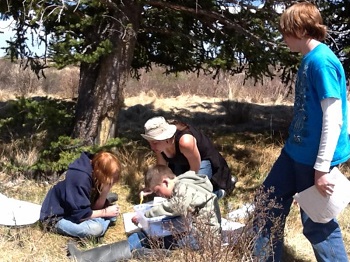
Conservation is a hallmark of National Heritage Areas. By conserving natural resources, National Heritage Areas in partnership with the National Park Service protect the character of place for the benefit of communities who live and work in the area. Conservation efforts lead to improved air and water quality, healthy ecosystems, beautiful places to live, and countless other benefits. Last year alone the NHAs restored 11,000 acres of land through invasive species removal, replanting, and toxic site clean-up.
In the Hudson River Valley NHA, the Rockland Farm Alliance (RFA) is aiming to increase the number of regional farms and sustainable farming educational programs. Through education and outreach, RFA helps prepare land for farming and provides guidance to new and emerging farmers. Similarly, Blue Ridge NHA (BRNHA) supports the Appalachian Sustainable Agriculture Project, which links new farmers to available land and stimulates farm tourism. BRNHA highlights traditional agricultural practices such as forestry and orchard keeping, as well as recent specialty crops like wine grapes and Christmas trees. They celebrate agricultural history as well as innovative agricultural development.
Shenandoah Valley Battlefields National Historic District's battlefield conservation plan incorporates environmental protection, watershed work, agricultural development, as well as historic preservation. Since 2000, Shenandoah Battlefields Foundation has worked with local governments and property owners to double the amount of protected acreage in the area through easements. Much of the 6,000 acres are working farms, thus preserving the character of the battlefield while contributing to the economy.

In South Park National Heritage Area in Colorado, conservation is incorporated into educational programs. For the second year running, staff partnered with the Coalition for the Upper South Platte to bring middle school students to High Creek Fen, a rare, ecologically diverse wetland. Students learn about water quality monitoring and biological indicators in class before completing field work on World Water Monitoring Day. This unique program combines laboratory science with field ecology, while increasing students awareness of issues in their community.
Community organization is key in the Last Green Valley National Heritage Corridor, where volunteers and staff workto maintain 116 miles of waterway. In 2013, 206 volunteers dedicated 1237 hours at over 200 locations to monitor water quality. Water cleanup activities involved 1,100 people retrieving 13,500 pounds of trash.
Ambitious wetland restorations in Yuma Crossing National Heritage Area resulted in restoration of 1500 acres of wetlands within the challenging desert environment. The East Wetlands project is the result of a partnership with the City of Yuma, the Quechan Indian Tribe, Arizona Game and Fish Department, and the Bureau of Reclamation. The partners signed an agreement to each maintain 350 acres of wetlands in the Multi-Species Conservation (MSCP) Program, ensuring 50 years of maintenance.
The Schuylkill River National Heritage Area manages the Schuylkill River Restoration Fund Grant program, a private and publicly funded grant program designed to improve the quality and quantity of water in the watershed. Since its inception in 2006, 23 projects were successfully completed and an additional 17 are in progress. Results include thousands of feet of repaired stream-bank, invasive species removed along riparian buffers, and many best management practices installed in the five county area.
Throughout the country, National Heritage Areas are working with partners to conserve natural resources. Through innovative planning and outreach strategies, the NHAs highlighted above and their partners have promoted creative and comprehensive approaches to conservation. These efforts have resulted in the type of holistic development and community engagement that National Heritage Areas were created to achieve.
Last updated: December 13, 2016
